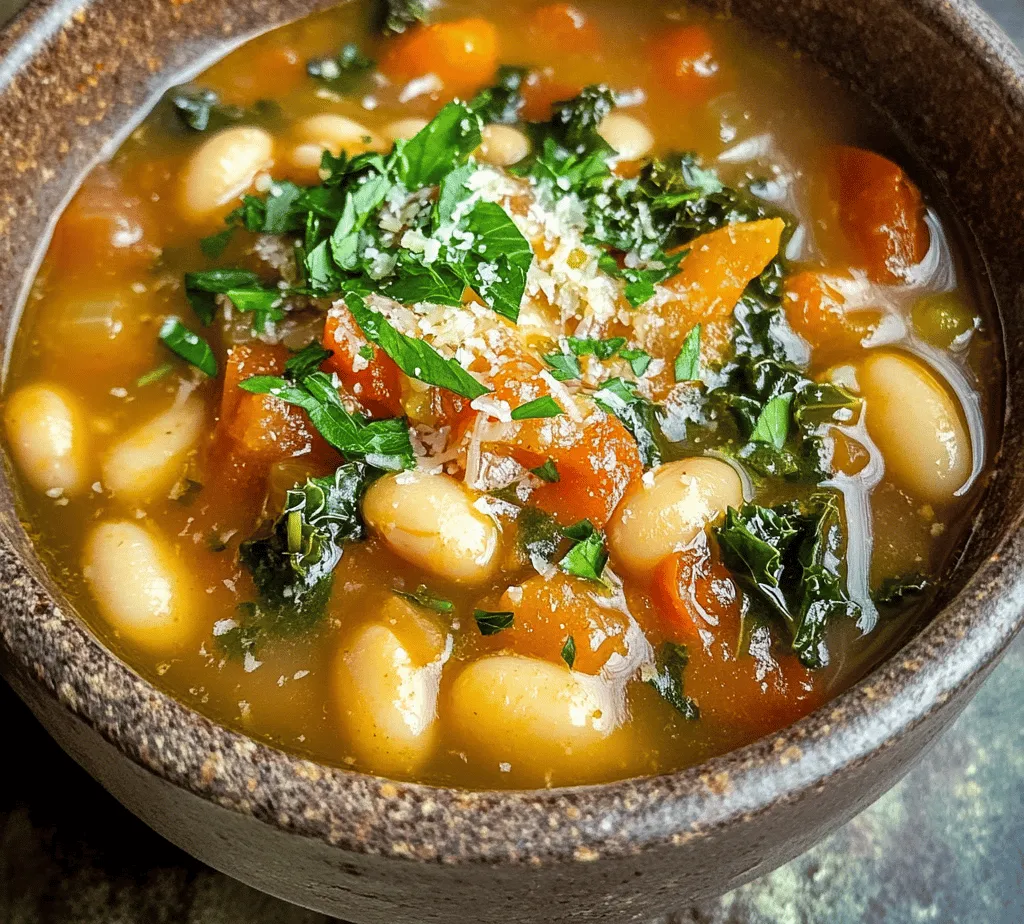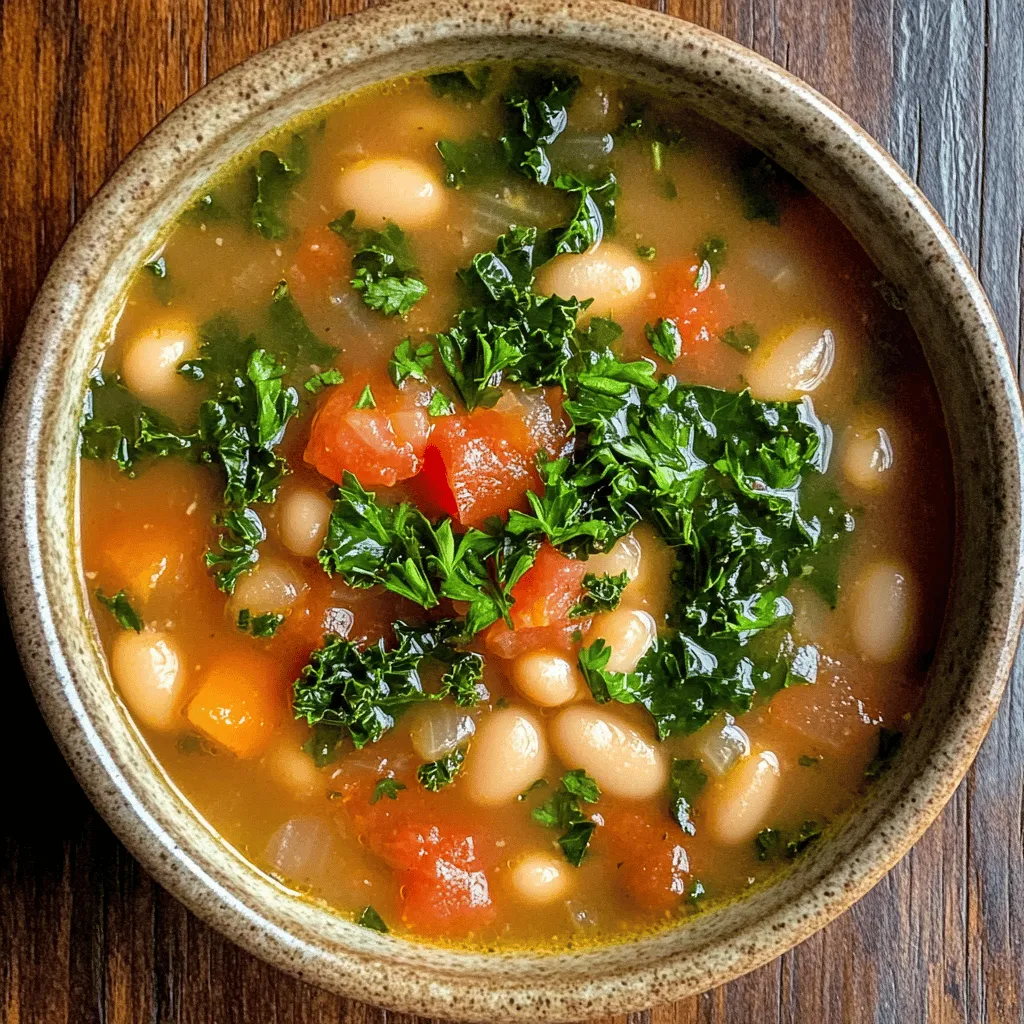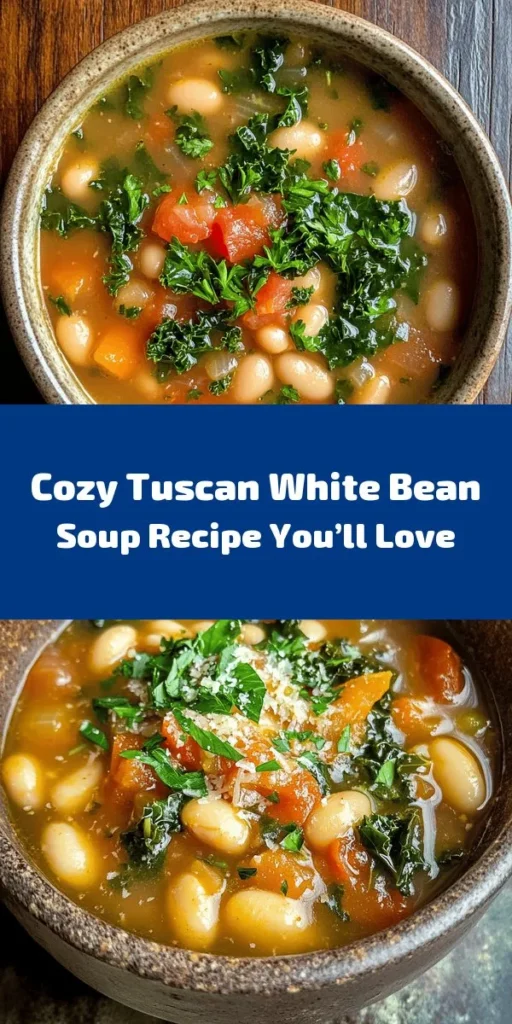Introduction
Tuscany, a beautiful region in central Italy, is renowned not just for its stunning landscapes and rich history but also for its vibrant and wholesome cuisine. Tuscan cooking is characterized by its emphasis on fresh, high-quality ingredients, often sourced from local farms and markets. The cuisine is deeply rooted in the principles of simplicity and seasonality, where the flavors of high-quality ingredients shine through. Among the many delightful dishes that hail from this region, Tuscan White Bean Soup stands out as a comforting and nutritious option that brings warmth to the table.
Tuscan White Bean Soup is not only a delicious meal but also a beacon of health, making it a perfect choice for those looking to incorporate more plant-based options into their diets. Packed with protein, fiber, and essential vitamins, this soup serves as a hearty meal that can be enjoyed any time of year. Its versatility allows it to be tailored to suit various dietary preferences, making it a favorite among vegetarians and meat-lovers alike. In this article, we will delve into the details of preparing this delightful soup, exploring the ingredients, their benefits, and sharing a step-by-step guide to mastering the recipe.
Understanding the Ingredients
To create a truly authentic Tuscan White Bean Soup, it is essential to understand the key ingredients that contribute to its rich flavor and nutritional profile. Each component plays a crucial role in building the dish’s character and ensuring a satisfying experience for the palate.
Key Ingredients Overview
1. White Beans:
The star of this soup is undoubtedly the white beans. Cannellini beans are the traditional choice, known for their creamy texture and nutty flavor. Great Northern beans are another excellent option, offering a slightly firmer texture. Both varieties are packed with nutrients, providing a good source of plant-based protein, fiber, and essential minerals, making them an ideal ingredient for a hearty soup.
2. Olive Oil:
As a staple of Mediterranean cooking, olive oil is fundamental in Tuscan cuisine. It not only adds a rich flavor to the soup but also contributes healthy fats, which are essential for heart health. Using high-quality extra virgin olive oil enhances the overall taste and brings a distinct character to the dish.
3. Aromatics (Onion and Garlic):
Aromatics are the backbone of flavor in many soups, and Tuscan White Bean Soup is no exception. The combination of sautéed onions and garlic creates a fragrant base that elevates the dish. Onions provide sweetness, while garlic adds depth and a hint of pungency, balancing the flavors perfectly.
4. Carrots and Celery:
These base vegetables are essential for building a robust flavor profile. Carrots add a touch of natural sweetness, while celery introduces a crisp texture and subtle earthiness. Together, they create a flavorful foundation that enhances the overall taste of the soup.
5. Vegetable Broth:
The choice of broth significantly impacts the soup’s flavor. For a vegetarian or vegan option, vegetable broth is perfect, providing a rich, savory base without any animal products. For non-vegetarians, chicken broth can be used to add an extra layer of flavor. It is essential to choose a high-quality broth, whether homemade or store-bought, to ensure the best results.
6. Diced Tomatoes:
Adding diced tomatoes to the soup introduces acidity and brightness, balancing the richness of the beans and olive oil. Tomatoes are also packed with vitamins and antioxidants, making them a healthy addition to the dish.
7. Kale or Alternative Leafy Greens:
To boost the nutritional value, kale is often included in Tuscan White Bean Soup. This leafy green is rich in vitamins A, C, and K, as well as fiber and antioxidants. If kale is not available, other leafy greens like spinach or Swiss chard can be used as substitutes.
8. Herbs and Spices:
A blend of herbs and spices is essential for flavoring the soup. Oregano and thyme are classic choices that bring a warm, earthy aroma to the dish. Additionally, a pinch of red pepper flakes can be added for those who enjoy a bit of heat. These ingredients layer the flavors, making each spoonful delightful.
9. Lemon Juice and Garnishes:
The finishing touch to the soup is a splash of fresh lemon juice, which brightens the flavors and adds a refreshing zing. This is typically followed by garnishing with fresh herbs or a drizzle of olive oil before serving, enhancing the dish’s visual appeal and flavor.
Preparation Method
Now that we’ve explored the essential ingredients that make up Tuscan White Bean Soup, let’s dive into the preparation method. This step-by-step breakdown will guide you through the cooking process, ensuring you create a soup that is not only flavorful but also satisfying.
Step 1: Sautéing Aromatics
Begin by heating a generous drizzle of extra virgin olive oil in a large pot or Dutch oven over medium heat. Once the oil is shimmering but not smoking, add finely chopped onions. Sauté the onions for about 5-7 minutes, or until they become translucent and slightly caramelized, stirring occasionally to prevent burning.
Next, add minced garlic to the pot. Sauté the garlic for about 1-2 minutes, allowing its aroma to fill the kitchen. Be careful not to let the garlic brown, as it can turn bitter and affect the soup’s flavor.
Step 2: Building Flavor with Carrots and Celery
Once the aromatics are ready, it’s time to build the flavor base with carrots and celery. Add diced carrots and chopped celery to the pot, stirring well to combine them with the onion and garlic. Continue to sauté the mixture for an additional 5-7 minutes, allowing the vegetables to soften and meld together. This step is crucial, as it enhances the soup’s texture and taste.
Step 3: Adding Beans and Broth
After the vegetables have softened, it’s time to introduce the star ingredients: the white beans and broth. If you are using canned beans, make sure to drain and rinse them before adding them to the pot. Stir in the beans, allowing them to absorb the flavors from the sautéed vegetables.
Pour in the vegetable or chicken broth, ensuring that all the ingredients are submerged. Bring the mixture to a gentle simmer, allowing the soup to cook for about 20-25 minutes. This simmering process allows the flavors to develop and deepen, creating a rich and hearty broth.
Step 4: Incorporating Diced Tomatoes and Greens
Once the soup has simmered, it’s time to add the diced tomatoes and kale (or your chosen leafy greens). Stir in the diced tomatoes, including their juices, and let the soup return to a simmer. The acidity of the tomatoes will balance the richness of the beans and olive oil.
After a few minutes, add the chopped kale to the pot. Stir it in and let it wilt, which should take about 3-5 minutes. The kale will provide a vibrant green color and a nutrient boost to the soup.
Step 5: Seasoning to Perfection
As the soup continues to simmer, it’s essential to season it properly. Add dried oregano, thyme, and a pinch of red pepper flakes to enhance the flavor profile. Taste the soup and adjust the seasoning with salt and pepper as needed. This step is vital as it ensures that the soup is well-balanced and flavorful.
Step 6: Finishing Touches
After simmering for about 30-35 minutes, once all the ingredients are tender and the flavors have melded together beautifully, remove the pot from heat. Before serving, add a splash of fresh lemon juice to brighten the soup, enhancing its taste.
Now that you have mastered the initial steps of preparing Tuscan White Bean Soup, you’re well on your way to creating a delightful and nutritious meal that embodies the essence of Tuscan cuisine. In the next part of this article, we will explore variations of the recipe, additional tips for perfecting your soup, and common questions related to its preparation. Stay tuned for more insights into this hearty delight!




